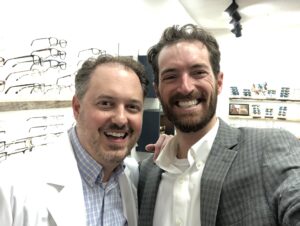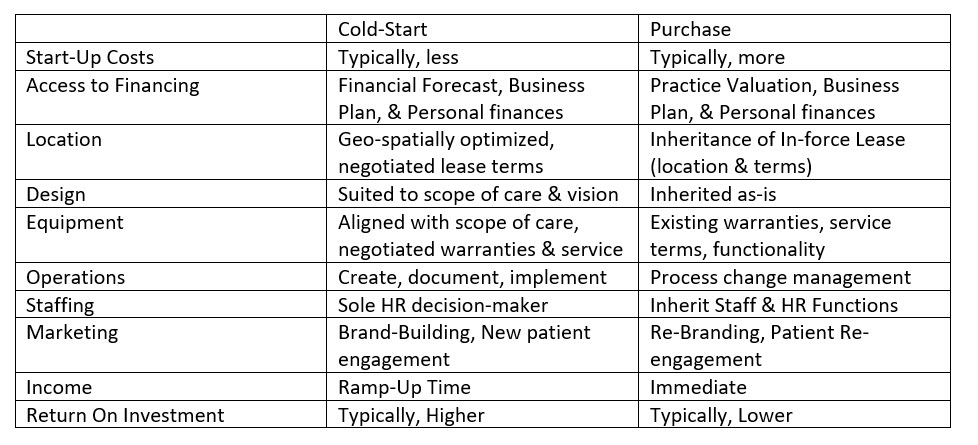
Erich Mattei, MBA (right as you are looking at photo), with Jay Fuller, OD, who owns Gulf Coast Vision in Gulfport, Miss. Mattei says it is important to carefully weight the advantages and disadvantages to opening cold and purchasing a practice before deciding which is right for you.
Key factors to consider when deciding to cold-start or buy a practice.
By Erich H. Mattei, MBA
Jan. 3, 2024
The public health need for vision and medical eyecare continues to grow at a rapid rate, as does the scope of care of modern optometry. Thus, opportunities abound for the next generation of optometrists seeking to serve their communities in a practice of their own.
The starting point for many emerging practice owners is determining which path to ownership is right for them: cold-start or purchase.
Here are five key considerations along with a quick-reference Rules of Thumb chart for determining which path to practice ownership is the right fit for you.
Mission, Vision & Purpose
Mission, vision and purpose establish a foundation for long-term strategy and short-term tactics, and the tenets that shape organizational culture. Though similar, these terms refer to starkly different statements, each critically important as the next.
- Mission- what the organization does and for whom.
- Vision—what the organization aspires to be.
- Purpose–the reason(s) the organization exists.
What do these mean for the emerging practice owner?
Self-reflection and identification of one’s professional mission, vision and purpose are the first steps in the journey to practice ownership. The potential practice owner should weigh their ownership options, identifying:
What your practice shall provide and to whom?
What you aspire to be in your community and in the profession?
The reason your practice shall exist?
Answering those questions will provide you with a values-based rubric to compare cold-starting versus purchasing a practice.
Financial Feasibility
What does it mean to practice “top-of-license,” “full scope” or “specialty” optometry? Much has changed in the last decade as the demand for vision and medical eyecare has grown. Industry investing in research and development, colleges of optometry expanding training and regulatory agencies modernizing licensure have opened new opportunities for the next generation of ODs striving to be practice owners.
Other Articles to Explore
Though the modern private practice may now present in a variety of forms pending the core scope of care and product offerings, the process of creating a financial pro forma to determine financial feasibility is an eye-opening exercise. Doing so will provide you with clarity around start-up costs, cash flow projections and profitability.
Steps to create a financial pro forma:
- List the scope of care and products you wish to offer (and areas you seek to expand into)
- Quantify the start-up costs: equipment and operations, location and buildout, staffing and marketing
- Conduct geo-spatial analysis and market research in your area to approximate demand (Pro tip: datausa.io provides free census-backed, demographic and economic stats by metro area)
- Construct revenue and expense forecasts to evaluate operating cash flows, identify break-evens and establish production benchmarks
- Lastly, incorporate debt service requirements into the analysis to determine viability
When evaluating financial feasibility of cold-starting versus purchasing be sure to do the following:
- Include the purchase price in the start-up costs
- Utilize historical financials of the practice for sale to establish baseline cash flow (Pro tip: if you have not been provided CPA-prepared financial statements by the seller, ask for them! These are necessary for your full analysis and due diligence. Also, your lender will require these financial statements (and more!) to explore financing options.)
- Apply your desired scope of care and product offerings (revenue and expense projections) to the baseline cash flows provided by the seller
- Project financial and operational requirements necessary to maximize each profit center across the practice, comparing cold-start versus purchase at various points along your time horizon
Determining financial feasibility is the foundation when establishing a business. These analyses provide a detailed snapshot of start-up costs and cash flow projections, net-of-debt service requirements—invaluable financial insights for determining if cold-starting or purchasing a practice is the appropriate path to ownership.
Control
Control is another consideration when evaluating if cold-starting or purchasing a practice is the right fit. Private practice ownership demands leadership and management ability (no matter your prior experience). Having full creative capacity versus inheriting established systems, and making decisions autonomously versus collaboratively, are just a couple points to evaluate when determining if cold-starting, purchasing or partnering is right for you.
Reflect on each of these to gauge how much control you seek in practice ownership:
- Are you more into the “details” or “big picture”?
- Do you seek outside opinions when making decisions (big or small)?
- How comfortable are you delegating?
- How frequently do you seek input from others when making financial decisions?
If you seek greater degrees of control in the planning, development and launch of your practice, cold-starting is likely the best fit for you.
Risk Tolerance
Banks compete heavily for the business of optometrists cold-starting or purchasing a practice because the business of optometry (and many healthcare specialties) is comparatively low-risk. While there is no guarantee of results, there are aspects of the market for vision and eyecare that mitigate degrees of business risk for optometrists in private practice:
- Demand for healthcare is relatively inelastic– it’s less affected by recession and other exogenous macroeconomic factors that impact demand for goods and services.
- Scope of care of modern optometry is expanding rapidly to serve growing public health need for vision and medical eyecare.
- Professional training and licensure offer barriers to entry, thereby restricting supply (less supply = less competition; less competition = less risk).
Optometrists have a strong track record for establishing viable businesses. (Pro tip: Research the industry in various business publications and databases to get an idea, using SIC 8042 and NAICS 621320.) Each entrepreneur has a unique risk tolerance, and in the context of practice ownership, cold-start typically bears greater risk than purchasing an established practice. However, investors being risk averse shall only bear that risk if the benefit stream is justifiable, hence cold-starting is likely to provide higher ROI over mid- to long-term time horizons. (See Rules of Thumb below for more on risk and profit.)
Exit Strategy
Time horizon and exit plan are important considerations across your career, impacting your ability to achieve financial and professional goals. When purchasing or partnering in a practice, the exit strategy of the seller is critically important:
- Is the purchase a buy-in? If so, how long will you remain in partnership with the seller(s)?
- Is the purchase 100 percent buy/sell? If so, what is the seller(s’) involvement in the practice post-sale?
Additionally, it’s never too early to develop your exit strategy! Here are questions to get you started thinking long-term about your exit:
- How many years until your exit from practice ownership?
- What are your plans to add additional locations, associate providers, etc.?
- Do you seek additional partners over your practice lifecycle?
- What does your ideal exit strategy look like?
- What are your “post-exit” plans?
- What are your income requirements post-sale?
Exit strategy—timeline and transition plan—are part of every entrepreneurial venture. When purchasing or partnering in a practice, understanding the seller(s) exit strategy is critically important to the business and your financial future. And for the reader, ideating your own professional plan and exit can provide direction into whether cold-starting or purchasing is the best path to practice ownership.
Rules of Thumb
We’ve identified prudent values-based items to evaluate when determining if cold-starting or purchasing an optometry practice is right for you, but a clear financial comparison is highly recommended. The following rubric provides a snapshot of key Rules of Thumb to consider when evaluating the financial aspects of cold-start or purchase:

Conclusion
It is imperative for ODs to weigh all key factors—financial, administrative and operational—before making the huge decision of whether to cold-start or buy a practice.
 Erich H. Mattei, MBA, is President and Chief Vision Officer of Akrinos. His mission is to make the business of eyecare approachable, accessible and profitable. In so doing, he consults with private practices across North America, provides strategic advisory to some of the biggest names and hottest start-ups in eyecare, and empowers modern ECPs as a continuing education and keynote speaker. To contact him: erich@akrinos.com
Erich H. Mattei, MBA, is President and Chief Vision Officer of Akrinos. His mission is to make the business of eyecare approachable, accessible and profitable. In so doing, he consults with private practices across North America, provides strategic advisory to some of the biggest names and hottest start-ups in eyecare, and empowers modern ECPs as a continuing education and keynote speaker. To contact him: erich@akrinos.com



























